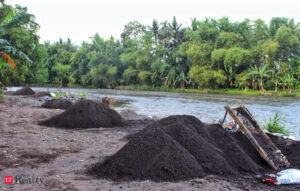Cotton is passé. Can India ever make it big in this fashionable textile market?

The price of cotton apparels had risen during the pandemic, and the fishermen switched to polyester clothing. Besides being cheaper, they dried quickly. Techno Sportswear’s T-shirts, particularly, offered better ultraviolet ray protection, and its antimicrobial properties ensured that the shirts did not stink even when they were at sea for days. The word spread.
“Today, one out of three fishermen, anywhere between Kanyakumari and Chennai, use our brand,” Jhunjhunwala claimed.
In the world of textiles, such polyester T-shirts, or those made with viscose or a blend of synthetic fibres, are technically called man-made fibres (MMF). Unlike the fishermen, other Indian consumers have been slow to use them. India remains predominantly a cotton market—over 60% of the domestic demand is for cotton textiles. But globally, it is a different story. According to the International Cotton Advisory Committee, the share of cotton in the world textile fibre consumption in 1960 was 68%. Textile Exchange, a US-based non-profit, puts cotton’s share in 2023 at just 20%. MMF accounts for 74% of the consumption.
“Consumers, world over, have moved to functional clothing and cotton is not able to meet their expectations. MMF offers the versatility they seek,” said Jhunjhunwala. “Demand for cotton apparel will continue to decline,” he predicted.
Functional clothing refers to clothes used for specific use cases, such as gym or office.
The problem? In the export market, India remains a cotton giant. In 2023-24, its man-made fibre-based textile exports accounted for just 14% of its total exports. India, therefore, is a marginal player in the fast-growing global MMF textile market which is dominated by China, Taiwan and Vietnam. India’s relevance in a market it historically dominated is increasingly under question, experts said.
What can India do to catch up? First, let’s understand why Indian businesses have been slow to make MMF textile products.
Innovation vs efficiency
Chemistry fascinated Gopinath Bala. He completed a PhD in polymer chemistry in the US in 2002 and was then involved in three projects for the National Aeronautics and Space Administration (NASA) in nanomaterial and space applications, including for its Mars programme. He returned to India in 2007 to manage Sri Venkatalakshmi Spinners Pvt. Ltd, a spinning mill owned by his family, at Udumalpet near Coimbatore. Realizing that cotton spinning was becoming unremunerative, he shut down the mill in 2016 and forayed into technical textiles—a category of textiles that find application in defence, automobile, aviation and aerospace sectors.
Bala developed two products—a biodegradable fabric (for signage printing to replace flex fabric that is presently used) and awnings and tensile structures (fabric that is increasingly used for roofs instead of sheets and metals).
Eventually, Bala wants to make airbags for cars but only after the two products generate adequate cash flows.

View Full Image
“It took me more than three years to develop these two products. Unlike in the case of cotton textiles, the lead time for developing MMF apparels or technical textiles is long. You need to really dirty your hands,” said Bala.
The products go through multiple iterations before the desired quality is reached. This will also mean higher investment. He expects the airbags project to take at least four years before it is ready.
MMF and technical textiles call for an approach that is very different from cotton. “Advanced textile is based on functionality and is heavily knowledge-based. It calls for an innovation-based approach and this is very different from the efficiency-based approach that existing cotton textile entrepreneurs are used to,” said Bala.
Take the case of raw material. Unlike cotton, it is very important to know the structure of a polyester yarn as it has a direct bearing on performance. There are hundreds of polyester yarn types, and each come with numerous varieties, and they have to be studied for 20-odd parameters such as contraction, stretchability, shrinkage or crimp stability before the right yarn is identified for a particular apparel, said R.M. Lakshman Narayan, director, Menaka Mills Pvt. Ltd, a major supplier to Decathlon, the largest sports goods retailer in the world.
Unlike cotton, it is very important to know the structure of a polyester yarn as it has a direct bearing on performance. There are hundreds of polyester yarn types, and each come with numerous varieties.
That possibly explains why very few cotton textile entrepreneurs are open to diversifying into MMF or technical textile. Bala expects only 15% of existing players in the textile space to move into the technical textile space and another 40% to foray into advanced textile involving MMF.
To cut a long story short, developing technical textile products is simply more technical and requires higher effort and patience.
Raw material conundrum
There are other bottlenecks. India is the second largest producer of polyester and viscose in the world. However, MMF players suffer from the lack of good quality raw materials such as polyester filament yarn.
“The quality of polyester filament yarn available in India is not up to global standards. It is far inferior to those available in China, Taiwan or Vietnam in terms of versatility,” complained JhunJhunwala.
Indian raw material suppliers have not innovated like their counterparts in other parts of the world. There is a reason for it. “Indian polyester industry is very domestic focused and prices are low. There is no incentive for the polyester filament yarn manufacturers to invest and be innovative. Once MMF textile exports pick up, the quality of raw material will improve,” said Rajkumar Agarwal, managing director, SVG Fashions Pvt. Ltd, a polyester fabric and apparel maker. He also heads Raj Rayons Industries Ltd which makes polyester filament yarn, among other things.
But it is a chicken and egg situation, Agarwal added—good quality polyester filament yarn is essential to crack the export market.
Jhunjhunwala’s TechnoSportswear imports almost all its requirements of polyester filament yarn from China. The company hopes to achieve a turnover of ₹500 crore in 2024-25 and has recently raised ₹175 crore from A91 Partners, an early growth equity fund.

View Full Image
But importing raw material is not easy either.
The government has applied the Quality Control Order (QCO), a regulatory standard that ensures that products sold in India are of good quality, on select polyester filament yarn imports such as ‘fully drawn yarn’. To qualify for selling under QCO, the importer must get Bureau of Indian Standards (BIS) certification.
“Chinese companies can’t register for BIS certification, and this means imports from China are ruled out,” said Agarwal.
Techno Sportswear has stopped making apparel using ‘fully drawn yarn’. Instead, it uses another variety called‘drawn texturised yarn’. Jhunjhunwala dreads the day when QCO will also be applied onthis variety.
“We need to have an open policy on raw material if India has to make it big in MMF garments,” said Jhunjhunwala. “In a global supply chain, you cannot ignore China. We need to work with them, learn to match them and then beat them. What is the point in insulating ourselves from the most efficient supply chain?” he asked.
In a global supply chain, you can’t ignore China. We need to work with them, match them & then beat them.
—Sunil Jhunjhunwala
By allowing the free import of raw materials, the Indian MMF-based textile industry will develop, attain scale and export. Once this happens, the quality of the domestically available raw materials will improve. Eventually, imports will drop. “This is the logic that the government is following for manufacturing cell phones. Most of the components come from China. Why should the textile sector be treated differently?” Jhunjhunwala further questioned.
‘Make-in-China policy’
What makes things worse is that the quality norms that apply for raw materials like polyester filament yarn are not applicable to downstream products such as fabrics. “Every day, 800,000 kgs of MMF fabrics come from China. Till March, they were imported at $1 per kg which is lower than even the cost of yarn in India,” said Agarwal.
After a hue and cry, a minimum import price of $3.5 per kg was imposed in March across five product categoriesfor a period of six months. Importers began importing under other categories. There are 50 of them for the MMF fabric category. “The government has now imposed a minimum import price across 13 product categories and extended it till December,” said Agarwal.
Cheap imports apart, India allows Bangladesh to export garments duty-free as part of the South Asian Free Trade Agreement. “The issue here is that Bangladesh imports MMF fabric from China duty-free, converts it into garments and ships it to India duty-free. In effect, we are allowing duty-free import of Chinese fabric,” said Agarwal.
This policy needs to be corrected for a strong MMF industry to develop in India. “You can’t restrict the import of raw material and allow free flow of downstream products. This is make-in-China policy,” he added.
Missing link
Significant quality issues apart, India has adequate capacity to produce MMF yarns. It is building reasonable knitting and weaving capacity but what it really lacks is processing infrastructure, especially dyeing. Stringent pollution norms and poor prices in the domestic market are preventing domestic industry from setting up adequate dyeing facilities. There are other reasons too.
“The chemistry of dyeing MMF is very different from that of cotton. The machines used are different and the process is different and involves additional processes. It takes at least five to six years to perfect the dyeing process,” said Maneka Mills’ Narayan.
Significant quality issues apart, India has adequate capacity to produce MMF yarns. It is building reasonable knitting and weaving capacity but what it really lacks is processing infrastructure, especially dyeing.
The government may have to step in and set up common effluent treatment plants to help the sector evolve. “These can be done under the PM-MITRA scheme which seeks to create world-class infrastructure for the textile sector,” said Agarwal.
During a recent visit to Taiwan, Narayan, to his surprise, found that the industry there uses 70 litres of water to dye a kilo of fabric. At Menaka Mills, after six years of work, he has brought down the water usage to just 26 litres. “This shows we can be the best in the world even in the MMF space. Just give us a level playing field,” he said.
PLI boost
To be fair, the government of India is working to make the sector more competitive—in recent years, it has come out with policy measures to boost MMF textile and technical textile production.

View Full Image
A production-linked incentive (PLI) scheme for MMF fabric, MMF apparel and technical textiles was unveiled in September 2021 with a budgetary outlay of ₹10,683 crore. Thus far, 64 applications have been approved under the scheme involving an investment of ₹19,798 crore.
The government also announced a National Technical Textiles Mission and 168 research projects have been approved so far under it.
These measures have belatedly kick-started India’s MMF and technical textiles journey but the road ahead is still challenging. Like we mentioned earlier, the mindset of entrepreneurs in the textile sector is still cotton-focused. And those who have taken the plunge are facing multiple constraints—lack of a proper eco-system, regulatory bottlenecks on raw material availability and rampant low-priced imports. While domestic demand has been slow to pick up, global buyers are yet to accept India’s MMF credentials.The industry is hoping that at least the import policies, those that are hurting them, can be reversed.










